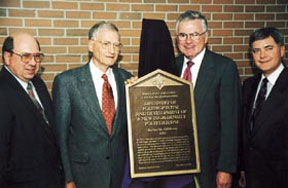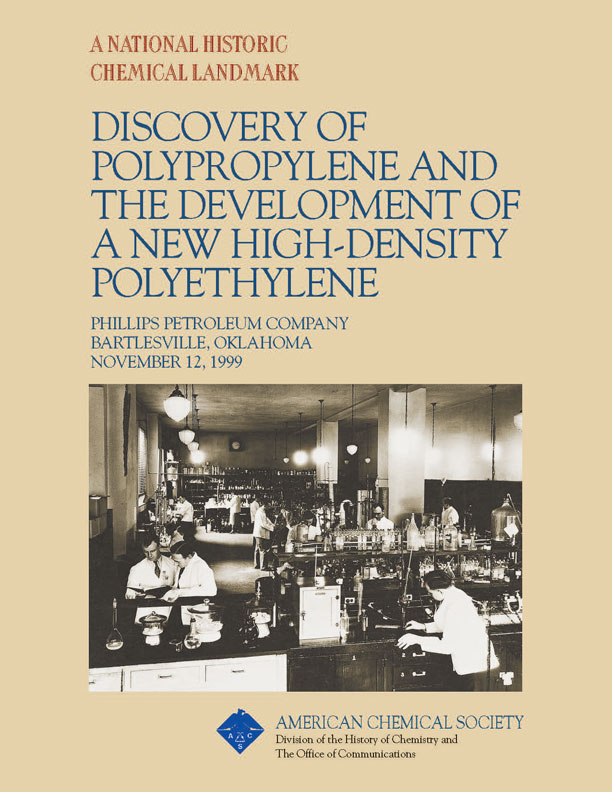Discovery of Polypropylene and High-Density Polyethylene
Dedicated November 12, 1999, at Phillips Petroleum Company (now ConocoPhillips) in Bartlesville, Oklahoma.
Phillips Petroleum Company in Bartlesville, Oklahoma, entered the plastics business in 1951, following a discovery by researchers J. Paul Hogan and Robert L. Banks. The two researchers found the catalyst that would transform ethylene and propylene into solid polymers. The plastics that resulted — crystalline polypropylene and high-density polyethylene (HDPE) — are now the core of a multibillion-dollar, global industry.
Contents
- Phillips Petroleum Company and Plastics
- Marketing Marlex®: From Hula Hoops to Plastic Tubing
- Uses for Polypropylene and High-density Polyethylene (HDPE)
- J. Paul Hogan and Robert L. Banks
- Patent Litigation of Catalytic Polymerization of Propylene
- Further Reading
- Landmark Designation and Acknowledgments
- Cite this Page
Phillips Petroleum Company and Plastics
In 1951, polymer chemistry was still in its infancy. The key people at Phillips had little, if any, experience with plastics. But the company had a history of trying new ideas and supporting and funding their development.
In 1925, research director George Oberfell convinced founder Frank Phillips to investigate additional uses for natural gas liquids. Two years later, Oberfell established one of the world's first hydrocarbon research laboratories, moving the company into new arenas in the production and marketing of fuels and of raw materials for the chemical industries. In 1935, he urged the company to acquire vast quantities of natural gas acreage and to pursue research on the separation of natural gas into its various components. So if Hogan and Banks's discovery was in fact serendipitous, it was not accidental: Phillips had set the stage for important innovations in the uses of natural gas.
In the late 1940s, as World War II ground to a halt and wartime demands for oil diminished, Phillips looked for ways to expand its product lines. With large quantities of natural gas on hand, Phillips chemists and engineers investigated ways to utilize propylene and ethylene, products of the refining process. Hogan and Banks were assigned to study the processes by which these gases could be converted into gasoline components.
In the course of these investigations, Hogan and Banks began to study catalysts and what makes them work. In June 1951, they set up an experiment in which they modified their original catalyst (nickel oxide) to include small amounts of chromium oxide. Ordinarily, the combination would be expected to produce low-molecular-weight hydrocarbons. They fed propylene, along with a propane carrier, into a pipe packed with catalyst and waited for the expected results.
As Paul Hogan recalls it, he was standing outside the laboratory when Banks came out saying, "Hey, we've got something new coming in our kettle that we've never seen before." Running inside, they saw that the nickel oxide had produced the expected liquids. But the chromium had produced a white, solid material. Hogan and Banks were looking at a new polymer: crystalline polypropylene. Hogan said his reaction was immediate: He sat down at his desk and wrote up a patent idea, and he and Banks both signed it.
With full support from Phillips management, Hogan and Banks quickly switched their research efforts from gasoline production to the development of plastics. Their first step was to omit the nickel to be sure the chromium was acting alone. The next was to use their new chromium catalyst to produce an ethylene polymer. Though polyethylene had been invented in the 1930s (by the British company Imperial Chemical Industries), the production process required extreme pressures of 20 to 30 thousand pounds per square inch (psi), and it produced a branched, low-density polymer. In less than a year, Hogan and Banks developed a new process that required only a few hundred psi — and produced a high-density polyethylene (HDPE) far stiffer, harder and more heat-resistant than anything on the market. This new discovery launched Phillips into an entirely new industry: The manufacture of a family of polyolefin plastics that included both the polypropylenes and polyethylenes.
Phillips management nurtured the new plastics from laboratory discovery to commercial-scale production in less than six years — no small feat for an oil company new to the plastics industry! Today, chromium catalysts still account for most of the world's HDPE. Hundreds of different grades of resin are produced globally by a variety of manufacturing processes from scores of different variants on the original chromium catalyst.
A lot of empiricism and some serendipity is needed for success in the field of industrial catalysis... serendipity in science ripens into fruition only when the unexpected phenomenon is observed by a scientist with a large bump of curiosity..."
— P. M. Arnold, Vice President, Phillips R&D, The Chemist, April 1971.
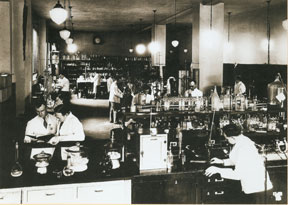
Marketing Marlex®: From Hula Hoops to Plastic Tubing
Phillips introduced HDPE in 1954, under the brand name Marlex® polyethylene. Company marketing executives were wildly optimistic, expecting that the product would be a big hit and that the Phillips would not be able to keep it on the shelves. But the market had become large and diverse and Marlex®, then produced in only one grade, was unsuitable for some applications. Inventories piled up in the warehouses.
The turnaround came from an unlikely source — a large ring of plastic tubing called the hula hoop. This children's toy became so immensely popular that the demand for Marlex® soared, taking the plant's entire output for nearly six months. Phillips president Paul Endacott was so delighted that he kept a hoop in his office for impromptu demonstrations. The toy's popularity continued long enough for Phillips to improve the production process and expand the number of available product grades.
The hula hoop craze helped pave the way for more practical uses, such as commercial and industrial tubing. In time, Marlex® also became the preferred plastic for baby bottles (because of its ability to withstand the high temperatures of sterilization) and for safe, shatterproof containers for food and other household products.
The discovery of crystalline polypropylene and the development of HDPE launched what is now a multibillion-dollar industry. The list below gives only a small idea of the impact of these plastics, which are used in thousands of applications. Polypropylene and HDPE play a role in the management of serious environmental issues. They are used in medical care and in public health and are essential materials in a variety of manufacturing industries and consumer-product companies. Importantly, these plastics also have created industries that provide thousands of jobs and business opportunities in this country and around the world.
Polypropylene | HDPE | |
Automotive | Battery cases and trays | Fuel Tanks |
Education | Binders | Classroom and stadium seating |
Environment | Geotextiles for erosion | Chemical toilets |
Home | Appliance housings | Food and drink containers |
Industry | Carpeting | Cable jacketing |
Medical | Medical implements | Biomedical waste containers |
Municipal | Ropes and twine | Highway barriers |
Recreation | Safety equipment | Basketball backboards |
It is hard to do justice to plastic because it serves so many functions, assumes so many guises, satisfies so many desires, and so quickly recedes into relative invisibility as long as it does its job well. In a little more than a century, plastics have spread throughout the material world, moving from almost no presence at all to near ubiquity.”
— Jeffrey L. Meikle, American Plastic: A Cultural History
Biography of J. Paul Hogan and Robert L. Banks
Considering their similar backgrounds, it seems fitting that J. Paul Hogan (1919-2012) and Robert L. Banks (1921-1989) would eventually come together as a team. The two grew up in small towns barely 100 miles apart.
Hogan was born in 1919 and spent his childhood in southwestern Kentucky, near the small town of Lowes. Banks was born two years later, in 1921, and grew up in the southeastern Missouri community of Piedmont. Both of their mothers were teachers. Banks' mother, Maude, was a music teacher before she married. Hogan's mother, Alma, taught elementary school. Banks' father, James, was a dentist in Piedmont. Hogan's father, Charles, was well known in Lowes as a farmer, mechanic and proprietor of a local store.
Banks received a B.S. degree from the University of Missouri-Rolla and an M.S. degree in chemical engineering from Oklahoma State University. Hogan received a B.S. degree in chemistry and physics from Murray State University, in Murray, Kentucky, in 1942. During World War II, Banks worked as a process engineer at an aviation gasoline plant in Coffeyville, Kansas, and Hogan became an instructor at an Army preflight school in Oklahoma. After the war ended, both men joined Phillips as research chemists — Hogan in 1944 and Banks in 1946. In 1949, they began their now famous collaboration.
After their discovery of polypropylene and the development of HDPE, the two men continued to make important contributions. Banks went on to discover olefin metathesis, a key factor in the growth of the synthetic chemical business. Hogan continued to develop the chromium catalyst for ethylene polymerization and led a research team dedicated to exploring chromium catalysts. Both men climbed the Phillips ladder, achieving the level of senior research associate. Hogan and Banks retired in the same year, 1985. Two years later, they received the Society of Chemical Industry's Perkin Medal for their contributions to chemistry. In 1998, the American Chemical Society gave Banks (posthumously) and Hogan a "Heroes of Chemistry" award for the use of petrochemicals in the automotive industries.
Patent Litigation of Catalytic Polymerization of Propylene
Paul Hogan and Robert Banks signed the patent idea describing the process by which they produced crystalline polypropylene about an hour after their discovery. The patent was issued 32 years later.
Remarkably, the catalytic polymerization of propylene at low pressure to polypropylene (with three different catalytic systems) was discovered within a brief period by researchers in three separate laboratories, none knowing that the others were even pursuing the problem.
Between 1951 and 1953, three patent applications on the discovery of polypropylene were filed — by Hogan and Banks; A. Zletz of Standard Oil; and Karl Ziegler of the Max Planck Institute. In 1958, the U.S. Patent Office declared an interference, a proceeding in which it heard evidence regarding the claims of these and two additional companies. Patent Office actions and the court battle that followed lasted three decades and produced volumes of testimony and scientific research. Indeed, the court's decision contained what may be the most complete scientific record of a crystalline material.
It was believed for many years that Prof. Ziegler and Italian scientist Giulio Natta were responsible for the discovery, because they had been the first to publish their findings — and because they had received the Nobel Prize for their work on these polymers. In 1983, an appellate court ruled that the patent did indeed belong to J. Paul Hogan, Robert L. Banks and the Phillips Petroleum Company.
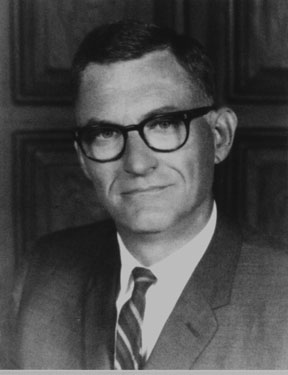
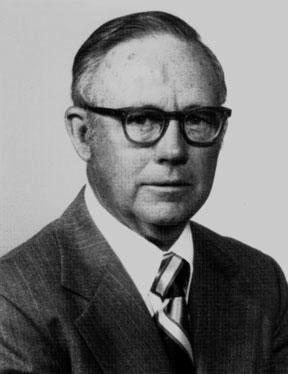
Landmark Designation and Acknowledgments
Landmark Designation
The American Chemical Society designated the discovery of polypropylene and the development of a new high-density polyethylene process as a National Historic Chemical Landmark at Phillips Petroleum Company (now ConocoPhillips Company), on November 12, 1999. The plaque commemorating the developments reads:
In 1951, while attempting to convert propylene into gasoline, J. Paul Hogan and Robert L. Banks of Phillips Petroleum Company discovered polypropylene, a high-melting crystalline aliphatic hydrocarbon. This discovery led to the development of a new catalytic process for the making of high-density polyethylene. Now, billions of pounds of polypropylene and high-density polyethylene are used each year in packaging of every shape and size, from milk jugs to large chemical drums; in toys, tools, furniture, and fibers; in water, sewer and gas pipes; and in auto parts. These polymers have become an integral part of our everyday lives.
Acknowledgments
Adapted for the internet from “Discovery of Polypropylene and the Development of a New High-density Polyethylene,” produced by the National Historic Chemical Landmarks program of the American Chemical Society in 1999.
Back to National Historic Chemical Landmarks Main Page.
Learn more: About the Landmarks Program.
Take action: Nominate a Landmark and Contact the NHCL Coordinator.
